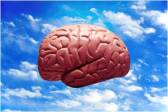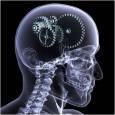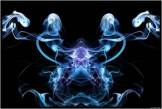Those (possibly very few reading here) who know tarot will recognize the “Zero” card in traditional decks as The Fool. The image for this card usually includes someone about to step off the cliff of the known world into empty air—carrying or wearing a pack. He is shown as care free and smiling. We consider it inherently foolish to step off solid high ground, oblivious to the fall that clearly seems so certain. But there may be something other than foolishness involved. There is an aphorism that says, “when you must move forward beyond the edge of the cliff one of two things will happen—firm support will appear under your feet, or you will sprout wings and fly.
Stepping off the very edge of the known world takes radical trust. Not just trust, but the ability to trust in trust itself. When the solid ground you’ve been standing on begins to shake and crumble beneath your feet, it may be wise rather than foolish to grab a few tools and step off.
I think about this new world thing today because I just returned from the OAGC fall conference in Ohio where I gave a keynote on Monday about the definition of giftedness as asynchronous development that was contributed to the field by the Columbus Group (yes, in Columbus on Columbus Day!) At that conference there were inevitably many people acutely aware of tremors in the ground beneath their feet.
In my small sessions for teachers questions were raised about how those dedicated to “doing no harm” to their gifted asynchronous students (or any others in their classes, for that matter) can be effective in a system that allows little breathing room and punishes teachers if their students do poorly on the tests that have come to rule the academic calendar. We spoke of good, even great, teachers leaving the field because of massive frustration. “It should not be this way,” we agreed. I reminded them that some states are beginning to change draconian testing policies and suggested that when things get bad enough, even massive systems have to change, a bit at a time. Finally, I found myself telling them to do whatever they can manage, and keep up their own spirits and their willingness to stick with it by finding at least one thing to be grateful for in every school day. Then I apologized for having only the tool to give them that Bernie Siegel offers to cancer patients facing uncertain outcomes. Has teaching come to this? But I don’t apologize for the tool, because it is a very powerful one.
New forms arise out of chaos, but it takes courage to hold on through the chaos. What we pay attention to expands in our experience, so it is important to focus on what works, no matter what else is going on around that.
For myself, what I noticed to be grateful for in the very large gathering at OAGC (as well as back in March at the NJ state conference) was the strongest sense of a shift in consciousness I have ever felt in such gatherings in this country. There is a growing awareness that our old way of thinking about “mind” as referring solely to rational thought within a rational/material world, is insufficient. No matter how good it is, the rational mind cannot predict what the world our children will face as adults will look like, what they will need to know, or what skills they will need to have to find a place in that world. As the pace of change continues to accelerate, educational patterns based on ideas about the human mind from decades, even centuries ago, will fail.
I put up a slide asking the conference attendees to consider their own definition or “sense” of what mind is, using at first these three images:
The first represents, of course, the traditional scientific belief that mind originates and resides in the physical brain, the second symbolizes the mechanistic cogwheels of intellectual/rational/logical thought, and the third a kind of nebulous, wispy not quite physical “something,” hard to pin down or “understand.”
Then I added a fourth image from painter Alex Gray:

This one acknowledges an energy basis of both mind and body.
The feel of a very big room full of educators, when offered these images, is more open these days. There seems to be a growing willingness to consider new ideas about what mind, what consciousness, may be.
This is deeply heartening to me, because the ground we’ve been standing on all these centuries (while we have been developing, using and relying on our quite splendid rational minds to understand and analyze and tame the material world) is demonstrably crumbling beneath our feet. Materialism, with its emphasis on separation, on particles rather than waves, leaves out something absolutely essential—what might be called the “heart” of humanity.
Here is a slide I have used in several talks to try to help broaden the concept of what mind consists of:
Aspects of Mind/Consciousness
Awareness Perception Emotion/Feeling
Intellect Imagination Memory
Will Intuition Compassion
Only a few of these aspects are addressed in most school curricula. We need to consider the world our children might help create if we began to recognize and value more of what can be called the non-rational aspects of our consciousness. The rational mind, focusing on analyzing, separating, labeling, categorizing and creating hierarchies, has brought us to where we are today, disconnected from each other and from the nature that supports us. We see the effects of this disconnection all around us and in every evening news broadcast.
The Columbus Group focuses not solely on intellect and achievement, but on the “whole child” in the education and raising of gifted kids. It is essential that we also begin to recognize “whole mind,” the “whole being” as we look to the human future. According to Jack Kornfield Sanskrit has only a single word for “mind” and “heart.” Imagine the difference it would make if we could heal the separation we now see between these two aspects of ourselves! It shouldn’t be such a huge stretch now that the field of neurocardiology is showing that the heart both receives and processes information.
The members of the Columbus Group who went to New Zealand in April for our Symposium on Asynchronous Development all felt something personally transforming happened there. That symposium began with an indigenous ceremony specifically recognizing the connectedness of all peoples, all beings, all aspects of our universe. Such a different way of beginning an educational gathering surely had a part to play in this noticeable sense of transformation.
For me this week it was a lovely synchronicity that October 12th is not only Columbus Day, but is called Indigenous Peoples Day in some places. The old world (that had long been inhabited when Columbus set sail to “discover” it) possessed valuable—non-rational—tools of consciousness most of Europe had forgotten, tools that are likely to be useful or even necessary for taking our own next step as the ground continues to shake beneath us all.




Just this week, Stef, I met a woman named Sneh. I asked her what that meant, because in Hebrew, it means “bush” as in the bush that G-d spoke to Moses out of, that “burned unconsumed.” She told me that it was a Sanskrit word meaning “Love.”
Mount Sinai, where that conversation took place, in Hebrew is “Har Sinai” which could be taken to mean “Mountain of My Bush” as in, the bush G-d spoke from. And if that bush is a representative of Love, then it could be “Mountain of My Love.”
Yes, language makes such a difference. When English splits things like heart, soul, mind, etc., it can seem more specific, but it creates dualities where oneness exists. Thank you, Stef, for writing so eloquently about how this concept comes into (or gets lost from) the classroom.
Thank you for this thought provoking post. I love the Alex Grey image of mind/body energy and use it in my Reiki teaching. It is the perfect visual to describe what use of “alternate energies” are available for those who search for meaning in our new world. Thank you for sharing your acute vision in words we all can understand. Date: Wed, 14 Oct 2015 21:50:43 +0000 To: mamalois@hotmail.com